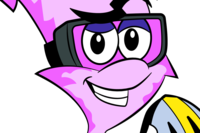Good Energy for Grownups: All In! — Connection and Wellness Page
0

Level 3/5Flash BoltonClassroom bot
2
Loading
1
Watch this video to
earn a point for your champ!
Discover valuable tips to help children and students of all abilities form new connections and practice wellness, presented by Special Olympics Unified Champion Schools (R).
[MUSIC PLAYING] Welcome to Good Energy for Grownups-- All In with Special Olympics Unified Champion Schools. I'm Tajha, a former US youth ambassador for Special Olympics North America. Today, we're discussing connection and wellness with some special guests. Hey, Kaleigh. Can you please introduce yourself, please? Of course. I'm Kaleigh Gardner. I am a former middle-level educator focusing in literacy and special education, and I am currently the education advisor for Special Olympics Unified Champion Schools. Sophia, can you please introduce yourself? Sure. I'm Sophia Arnold. I'm a high school special education teacher. I teach students with a range of intellectual disabilities. I'm a GoNoodle teacher ambassador and a mom of four beautiful children. How do you define and explain connection and wellness to children and students? Well, I would explain connection to children and students as the ability to simply connect with someone, build those relationships with people who are alike and different. I think it's very important for us to put the emphasis on someone who is different, someone who you usually probably wouldn't want to make that friendship or connection with. It's kind of that acknowledgment that other people exist. We're not walking around with blinders on. I think another great way to bring it together, both in the classroom and at home, simply is thinking of puzzles. So for connection, to me, is bringing two things together, whether it's two people or more. It can definitely be more. It can be between people, feelings, ideas, causes. We can connect means we see part of ourselves in that. And having two puzzle pieces, starting with two, and maybe have them represent different-- whether it's the feelings or the people, and having them come together to form that relationship to create something bigger. That connection. Yeah. Why are these topics important to discuss with children and students? I think these topics are important because, again, our end goal as parents and educators is to promote a healthy and long life for our students and children. And giving them the tools they need to do so will definitely aid in it. What about you, Kaleigh? I definitely agree with you on everything you just said about wellness. And I think connections is incredibly important because this world is filled with unique individuals. I think if our end goal is to also create an inclusive community inside and outside of the classroom, we need to help students connect with those of varying abilities, backgrounds, and perspectives. This will ultimately help guide their thinking, their perspectives. It will help them grow, and it will lead to a more, yeah, inclusive and empowering place. What tips do you have to help kids form new connections this year? Want to go for it? Yeah. OK. So I think it goes back to what we were talking about, this uncomfortable but safe opportunities. I think something easy that educators could put together in their classes, even, like, a get-to-know you bingo board. So going around. And that puts students in their classroom going around, seeing what those connections are, opening up those opportunities to talk with one another, see what they have in common, or don't. And it's just a great beginning of the year. And it's a great way that you can modify it for any grade level. The bingo board doesn't have to be huge. There can be so many spaces. You can use different pictures and different supports to help students complete it. You can even buddy them up, someone that they do feel safe with, to go around and increase their peer group. Have you done anything in your class to help build connections? Well, something similar. With the older students, I'll have them sit at a different lunch table in the lunchroom. We're so programmed to only sitting in our one spot with our friends. Switch it up today. I want you to sit at the third table. You sit at the fifth table. You sit at the eighth table. And after lunch, tell me something you learned about someone new. You're right. And I like what you said, out of your comfort zone, getting the students out of their comfort zone. When I was in elementary school, it was never you get out of your comfort zone. It was always you're going to stay in that zone and be in that zone. It's never, oh, Tajha, think outside the box. For me, it was always get uncomfortable sometimes. And sometimes I feel like, as little kids, we have to tell them, it's OK to be uncomfortable. It's OK to go out there. It's OK for you guys to do certain things. And as teachers and parents, I believe that's very powerful. Yeah. And like you said before, too, having them feel uncomfortable in a safe space. Yes. Yes. Yes. I was just going to say that. If they know they belong in our classroom, we are there for them. Like, yes, it's uncomfortable, but that's what helps us grow. Right. And we're going to show that growth and model it and be there together. Exactly. What are key takeaway parents and teachers should walk away with from this conversation? Well, again, I'm real big on modeling and intentionality. I think both parents and teachers should be extremely intentional about creating the environment so students can make connections, so students can understand what wellness looks like, what if feels like, and why it's important. And I think, also, just realizing all of the resources available on both Special Olympics and GoNoodle's websites between the young athletes materials, Fit 5. We have the High 5, Champ on GoNoodle. Implementing those, whether at home great energy busters, brain breaks in the classroom, we can implement wellness throughout our natural day, which ultimately will help them in the classroom. [MUSIC PLAYING]
